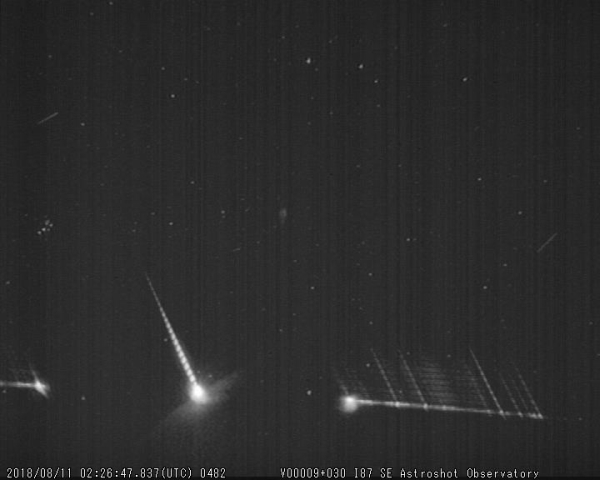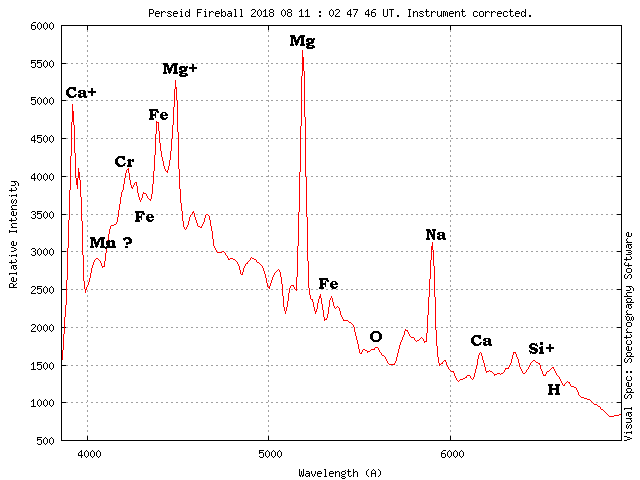- This topic has 13 replies, 5 voices, and was last updated 5 years, 8 months ago by
 Robin Leadbeater.
Robin Leadbeater.
-
AuthorPosts
-
11 August 2018 at 10:11 pm #574106
 Michael O’ConnellParticipant
Michael O’ConnellParticipantBright meteor from the early hours of this morning.
Spectrum also captured.
Regards,
Michael.


Attachments:
12 August 2018 at 9:29 am #579867 Andy WilsonKeymaster
Andy WilsonKeymasterGreat spectrum capture Michael with a good number of lines identified! And with the added bonus of the Pleiades in the image background 🙂
Andy
12 August 2018 at 10:42 am #579868 William StewartParticipant
William StewartParticipantHi Michael,
Very nice indeed. Picked that one up on the all-sky camera from Ravensmoor in Cheshire. Single station analysis pegs it as a -4.2 Perseid. Will send the files separately for triangulation analysis.
Best regards
William
 12 August 2018 at 5:35 pm #579873
12 August 2018 at 5:35 pm #579873 Bill WardParticipant
Bill WardParticipantHi,
The 8/9 and 10/11 Aug 2018 provided some good results. 31 spectra over both nights. This is the best Perseid (so far, maybe it’ll be clear tonight… ;-))
)

Here is the instrument corrected spectrum graph.
Note: I’ve cropped the O and N lines from the atmosphere, in the near IR. I’ve also binned by 3 to smooth out the de-slanting artifacts but probably at the loss of some small lines (mostly Fe).

It’s always re-assuring to see similar results from other observers. However there are two lines (or maybe very close bands) that I have not been able to tie down. I’ve got these on lots of Perseids from the last several years. Not sure what the bumps are around the Na line…. Could be any of several but at this resolution it’s difficult to be absolutely certain.
I also got a small section of this same meteor on another system. Almost perfect dispersion too… Still to process that one.
cheers,
Bill.
12 August 2018 at 7:53 pm #579875 Michael O’ConnellParticipant
Michael O’ConnellParticipantBill,
How did you carry out your instrument correction?
I thin thinking of adjusting the settings in the camera to stack the images and use Vega as a standard reference.
Alternatively, I could try a sodium street lamp I guess.
Michael.
13 August 2018 at 2:37 pm #579876 Bill WardParticipant
Bill WardParticipantMichael,
It’s easy enough to do but a pain to describe….
There are tutorials on the RSpec site (looks like that’s the package your using).
Also take a look on the Visual Spec site (http://astrosurf.com/vdesnoux/) , there’s a comprehensive tutorial using Vega. That’s the technique I use. I much prefer working with Visual Spec and IRIS. They don’t have the slick interface but I like the command line method, makes you think about what your doing.
cheers,
Bill.
13 August 2018 at 5:12 pm #579879 Bill WardParticipant
Bill WardParticipantMichael,
An update… After posting I decided to check the tutorial on the Visual Spec site. There is some sort of hack or virus or something going on. My laptop security went mental. Approach with caution…!
Bill.
13 August 2018 at 7:04 pm #579880 Robin LeadbeaterParticipant
Robin LeadbeaterParticipantHi Bill
Just checked the Visual Spec website and all looks fine this end. Was it a particular link on the tutorial page? (Some of them use flash which perhaps could have been flagged up as a security problem. ) If there is a problem then we need to let Valerie know.
Cheers
Robin
13 August 2018 at 7:20 pm #579881 Michael O’ConnellParticipant
Michael O’ConnellParticipantThanks Bill.
I’ve used Vega for calibration in RSpec previously when I used a Star Analyser in my telescope so I’ll stick with that method.
Thanks,
Michael.
13 August 2018 at 7:26 pm #579883 Bill WardParticipant
Bill WardParticipantHi,
I couldn’t find her address as I was going to do just that. Could be the Flash issue, I tried other pages and they were fine too. If you have her address it might be worth dropping her a line just in case. Feel free to reference my experience. It’s THE most important piece of software I use!!!
cheers,
Bill.
13 August 2018 at 7:57 pm #579884 Robin LeadbeaterParticipant
Robin LeadbeaterParticipantFlux calibrating these spectra even in relative flux is not trivial. Yes the standard method to correct for instrument response and extinction using a reference star measurement is ok in principle but there are a few extra things to watch out for which make it tricky when using this technique with wide field moving targets like this. Specifically flat fielding, background subtraction and differential extinction.
Flat field correction of any slitless spectra is complex as each point in the field is a combination of zero orders and diffracted light from other points in the field so there is no one to one correspondence like in conventional flats. In practise this is effectively impossible to untangle. With static targets you can get round this problem by measuring the reference and target spectra in the same position in the field, which is the way I recommend using the Star Analyser for example but this is obviously not possible for meteors of course so my suggestion would be to take a series of spectra of a bright standard star at different locations in the field and asses exactly how much effect it has on the spectrum. If the spectrum shape varies significantly then some allowance has to be made for this depending on the location of the meteor spectrum.
Similarly sky background subtraction is difficult compared with narrow field fixed targets where the sky can be measured directly above and below the spectrum. Perhaps this is not too much of a problem for short exposure videos of meteors though where subtraction of frames before and after the meteor could be used. (Linearity of the light response is obviously important – no gamma correction to be used)
Extinction effects over such a wide field can be significant and will vary along the trail. These could be corrected for using an atmospheric model and some sort of mean elevation figure for the meteor though.
Robin
13 August 2018 at 8:00 pm #579885 Robin LeadbeaterParticipant
Robin LeadbeaterParticipantHi Bill,
There is a link with her email at the bottom of the download page
http://astrosurf.com/vdesnoux/download.html
Cheers
Robin
21 August 2018 at 11:00 pm #579909 Bill WardParticipant
Bill WardParticipantHi,
An excellent summary of the problems! As strategies evolve one of the things I continue to do (after the “discovery” of the rapid changes in spectrum of the bright Perseid, 2013) is to examine the spectrum videos frame by frame. This is in an effort to mitigate some of the very noise and absorption issues you mention. By taking the shortest possible “length” of spectrum to sum up to get a viable spectrum. The best, of course only need one frame but on others you need to use longer temporal sections.
I have been saying for years that meteor spectroscopy is a tricky proposition analytically speaking. There are a few published papers by Jeniskens that discuss “quantitative” spectroscopy but without some assumptions I’m not fully convinced (maybe I just don’t understand the maths!)
Nobody knows any physical information about the particular meteoroid that produces a particular spectrum beforehand and THAT is the problem. EVERY other aspect of the meteor we then capture is entirely random. Time, position, duration, luminous efficiency (and that’s the big one…) etc.
All we can determine with any certainty is the geocentric velocity, then comes along a spectrum carrying all these observational variables, did I mention tricky… ;-))
I think this is one of the reasons that the technique of comparing particular line ratio’s (as devised by Borovicka) is about as good as we can get.
HOWEVER even with qualitative results significant differences is spectrum characteristics can be identified and I think that’s why sporadics are the most interesting proposition and what I’ve called Comparative Meteor Spectroscopy can get us into some sort of new taxonomy over the coming years as data builds up.
Observers have been conducting meteor spectroscopy for a lot longer than me but these programs caught large fireballs on rare occasions but I think I’ve been the first to do regular video meteor spectroscopy, (in the UK?), and that’s only been since 2008 (or 2006 if you include my very first tests). So we’re only just starting a new field. Another 10 years and we’ll have a whole new picture of what’s in our planets neighbourhood.
All we can do is work with what we’ve got…
cheers,
Bill.
22 August 2018 at 2:46 pm #579912 Robin LeadbeaterParticipant
Robin LeadbeaterParticipantHi Bill,
>I think this is one of the reasons that the technique of comparing particular line ratio’s (as devised by Borovicka) is about as good as we can get.
Even this needs a relative flux calibration though so instrument response including flat field issues and extinction still need to be considered.
My only foray into this branch of spectroscopy was back in 2005 and I was glad to at least get something before moving on to other targets
http://www.threehillsobservatory.co.uk/astro/spectra_20.htm
My mentor back then was Ed Majden who had been doing meteor spectroscopy as far back as the ’70s at least, using film, then video. Do you know if Is he still with us ? His website is down and the AMS website mentions him doing work in the 50’s so he must be getting on
https://www.amsmeteors.org/ams-programs/meteor-spectroscopy/meteor-studies-at-majden-observatory/
Your continuous monitoring though is certainly taking things to a new level, building statistically useful numbers of observations and working outside the normal showers.
It is an area where new developments in technology are moving in our favour too, with affordable large CMOS chips with low read noise, fast readout and improved bit depth compared with the old 8 bit cameras. High efficiency volume phase transmission gratings is another interesting development, though I believe they are still rather specialist/expensive.
Cheers
Robin
-
AuthorPosts
- You must be logged in to reply to this topic.
